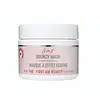What's inside
What's inside
 Key Ingredients
Key Ingredients

 Benefits
Benefits

 Concerns
Concerns

 Ingredients Side-by-side
Ingredients Side-by-side

Salicylic Acid 2%
MaskingGlycolic Acid 5%
BufferingLactic Acid 5%
BufferingWater
Skin ConditioningEthoxydiglycol
HumectantSodium Hydroxide
BufferingGlycerin
HumectantCitrus Grandis Peel Extract
AstringentCucumis Sativus Fruit Extract
EmollientChamomilla Recutita Flower Extract
MaskingAloe Barbadensis Leaf Extract
EmollientBeta-Glucan
Skin ConditioningAllantoin
Skin ConditioningDipotassium Glycyrrhizate
HumectantCaprylic/Capric Triglyceride
MaskingMenthyl Lactate
MaskingPPG-26-Buteth-26
Skin ConditioningPEG-40 Hydrogenated Castor Oil
EmulsifyingTetrasodium EDTA
Methylchloroisothiazolinone
PreservativeMethylisothiazolinone
PreservativeSalicylic Acid 2%, Glycolic Acid 5%, Lactic Acid 5%, Water, Ethoxydiglycol, Sodium Hydroxide, Glycerin, Citrus Grandis Peel Extract, Cucumis Sativus Fruit Extract, Chamomilla Recutita Flower Extract, Aloe Barbadensis Leaf Extract, Beta-Glucan, Allantoin, Dipotassium Glycyrrhizate, Caprylic/Capric Triglyceride, Menthyl Lactate, PPG-26-Buteth-26, PEG-40 Hydrogenated Castor Oil, Tetrasodium EDTA, Methylchloroisothiazolinone, Methylisothiazolinone
Water
Skin ConditioningPropanediol
SolventButylene Glycol
HumectantCyclopentasiloxane
EmollientGlycerin
HumectantPEG-240/Hdi Copolymer Bis-Decyltetradeceth-20 Ether
StabilisingPyrus Malus Fruit Extract
Skin ConditioningCitrullus Lanatus Fruit Extract
Skin ConditioningLens Esculenta Fruit Extract
Skin ConditioningPullulan
Camellia Sinensis Leaf Extract
AntimicrobialChrysanthemum Parthenium Extract
Skin ConditioningAlgae Extract
EmollientCucumis Sativus Fruit Extract
EmollientRosa Multiflora Fruit Extract
MaskingGlycyrrhiza Glabra Root Extract
BleachingPlankton Extract
Skin ConditioningTocopherol
AntioxidantSea Salt
AbrasiveAscorbyl Palmitate
AntioxidantDipotassium Glycyrrhizate
HumectantTetrahexyldecyl Ascorbate
AntioxidantSodium PCA
HumectantDimethicone
EmollientPolyglyceryl-10 Laurate
Skin ConditioningDivinyldimethicone/Dimethicone Copolymer
Caprylic/Capric Triglyceride
MaskingCaprylyl Glycol
EmollientPentylene Glycol
Skin ConditioningMenthoxypropanediol
MaskingStevioside
MaskingCarrageenan
Disodium EDTA
Hydrogenated Castor Oil Isostearate
Skin ConditioningSodium Lactate
BufferingSodium Dilauramidoglutamide Lysine
HumectantHydroxyphenyl Propamidobenzoic Acid
Skin ConditioningSodium Citrate
BufferingPhenoxyethanol
PreservativeXanthan Gum
EmulsifyingSodium Benzoate
MaskingPotassium Sorbate
PreservativePotassium Laurate
EmulsifyingWater, Propanediol, Butylene Glycol, Cyclopentasiloxane, Glycerin, PEG-240/Hdi Copolymer Bis-Decyltetradeceth-20 Ether, Pyrus Malus Fruit Extract, Citrullus Lanatus Fruit Extract, Lens Esculenta Fruit Extract, Pullulan, Camellia Sinensis Leaf Extract, Chrysanthemum Parthenium Extract, Algae Extract, Cucumis Sativus Fruit Extract, Rosa Multiflora Fruit Extract, Glycyrrhiza Glabra Root Extract, Plankton Extract, Tocopherol, Sea Salt, Ascorbyl Palmitate, Dipotassium Glycyrrhizate, Tetrahexyldecyl Ascorbate, Sodium PCA, Dimethicone, Polyglyceryl-10 Laurate, Divinyldimethicone/Dimethicone Copolymer, Caprylic/Capric Triglyceride, Caprylyl Glycol, Pentylene Glycol, Menthoxypropanediol, Stevioside, Carrageenan, Disodium EDTA, Hydrogenated Castor Oil Isostearate, Sodium Lactate, Sodium Dilauramidoglutamide Lysine, Hydroxyphenyl Propamidobenzoic Acid, Sodium Citrate, Phenoxyethanol, Xanthan Gum, Sodium Benzoate, Potassium Sorbate, Potassium Laurate
Ingredients Explained
These ingredients are found in both products.
Ingredients higher up in an ingredient list are typically present in a larger amount.
This ingredient is an emollient, solvent, and texture enhancer. It is considered a skin-softener by helping the skin prevent moisture loss.
It helps thicken a product's formula and makes it easier to spread by dissolving clumping compounds.
Caprylic Triglyceride is made by combining glycerin with coconut oil, forming a clear liquid.
While there is an assumption Caprylic Triglyceride can clog pores due to it being derived from coconut oil, there is no research supporting this.
Learn more about Caprylic/Capric TriglycerideThis extract comes from cucumber. Cucumbers are mostly made up of water (95%), and the other 5% is composed of: vitamin C, caffeic acid, fatty acids, amino acids, and other minerals.
Cucumbers have anti-inflammatory, barrier repair, and hydrating properties.
They contain shikimate dehydrigenase, an enzyme shown to help reduce inflammation and soothe the skin.
The amino acids found in cucumbers help nourish our skin's natural acid mantle (it's an important part of our skin barrier). This slightly acidic film acts as a barrier to protect us from bacteria, viruses, and other contaminants.
Unless you have an allergy to cucumbers, this is generally a non-irritating ingredient.
Fun fact: Cucumis Sativus is native to South Asia and can now be found on every continent.
Learn more about Cucumis Sativus Fruit ExtractDipotassium Glycyrrhizate comes from licorice root.
Extracts of licorice have demonstrated to have antibacterial, anti‐inflammatory, antiviral, antioxidant properties.
One component, glabridin, has extra potent antioxidant and soothing properties. It has also been found to block pigmentation from UVB rays in guinea pigs.
Licorice Root also contains a flavonoid. Flavonoids are a natural substance from in plants. Flavonoids also have antioxidant properties.
Another component, glycyrrhizin, has been found to have anti-inflammatory and antimicrobial benefits. This may make licorice root extract effective at treating acne. However, more research is needed to support this.
Liquiritin is one of the flavone compounds found in licorice. It has been found to help lighten skin by preventing tyrosinase from reacting with tyrosine. When the two react, protein is converted to melanin. Melanin is the substance in your body that gives your features pigmentation.
Licorice root is native to Southern Europe and Asia. It has been used in traditional Chinese medicine to help with respiratory issues.
Learn more about Dipotassium GlycyrrhizateGlycerin is already naturally found in your skin. It helps moisturize and protect your skin.
A study from 2016 found glycerin to be more effective as a humectant than AHAs and hyaluronic acid.
As a humectant, it helps the skin stay hydrated by pulling moisture to your skin. The low molecular weight of glycerin allows it to pull moisture into the deeper layers of your skin.
Hydrated skin improves your skin barrier; Your skin barrier helps protect against irritants and bacteria.
Glycerin has also been found to have antimicrobial and antiviral properties. Due to these properties, glycerin is often used in wound and burn treatments.
In cosmetics, glycerin is usually derived from plants such as soybean or palm. However, it can also be sourced from animals, such as tallow or animal fat.
This ingredient is organic, colorless, odorless, and non-toxic.
Glycerin is the name for this ingredient in American English. British English uses Glycerol/Glycerine.
Learn more about GlycerinWater. It's the most common cosmetic ingredient of all. You'll usually see it at the top of ingredient lists, meaning that it makes up the largest part of the product.
So why is it so popular? Water most often acts as a solvent - this means that it helps dissolve other ingredients into the formulation.
You'll also recognize water as that liquid we all need to stay alive. If you see this, drink a glass of water. Stay hydrated!
Learn more about Water